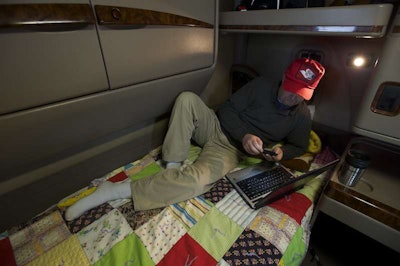 FMCSA will study 200 truckers to determine whether split sleeper berth flexibility affects drivers’ fatigue levels.
FMCSA will study 200 truckers to determine whether split sleeper berth flexibility affects drivers’ fatigue levels.Following incremental steps toward such a study in recent years, the Federal Motor Carrier Safety Administration will formally announce Tuesday a pilot program intended to gauge the feasibility and safety aspects of adding split sleeper berth options to hours of service regulations.
FMCSA says it seeks at least 200 drivers to participate in the study. Drivers will be studied for up to 90 days, per a Federal Register entry slated for publication June 6.
Current regulations allow drivers, as an alternative to a straight 10-hour off-duty period, to take an eight-hour sleeper berth period to break up their 14-hour on-duty limit and their 11-hour drive-time limit. Drivers using this provision must take a two-hour off-duty period after exhausting their 11-hour drive-time limit. The two-hour off-duty period counts against drivers’ 14-hour limit for the on-duty period broken up by the two-hour break.
The agency’s split sleeper berth pilot program seeks to determine the effects other split sleeper berth options, such as 5-5, 6-4 and 7-3, would have on drivers and their ability to operate. The study’s outcome could dictate whether FMCSA decides to pursue reforms to hours of service regulations pertaining to split sleeper berth flexibility.
FMCSA said last year it had partnered with Virginia Tech’s Transportation Institute and Washington State University to conduct the split sleeper berth pilot program.
Researchers will study the 200 (or more) drivers in their normal operations. However, drivers will be free to split their sleeper berth time into two segments of “any combination..totaling 10 hours.”
“Drivers would be able to use split or consolidated sleep schedules as they choose,” the agency says, “but they still must meet the daily minimum rest requirements.”
The study seeks to data from ELDs, monitoring systems like video recorders, roadside inspections, wrist actigraphy (studying total sleep time and wakefulness), psychomotor vigilance tests taken in cab, subjective sleepiness ratings as noted by drivers and sleep logs. Researchers will then study the data and make conclusions regarding the positive or negative outcomes of drivers using split sleeper berth options.
FMCSA is soliciting carriers and drivers to participate. Those interested in participating should visit sleeperberthstudy.com to complete an application, take a questionnaire and provide written consent to be studied.
The agency has not said how long the data collection phase will last in sum, only saying individual drivers will be studied for up to 90 days. It also did not say how long it would take to produce conclusions based on the data gathered.
Public comments about the study are being accepted for 60 days, giving carriers and drivers the chance to provide the agency with input about the study and how it should proceed. The comment period opens Tuesday and will be available at the regulations.gov rulemaking portal via Docket No. FMCSA-2016-0260.











